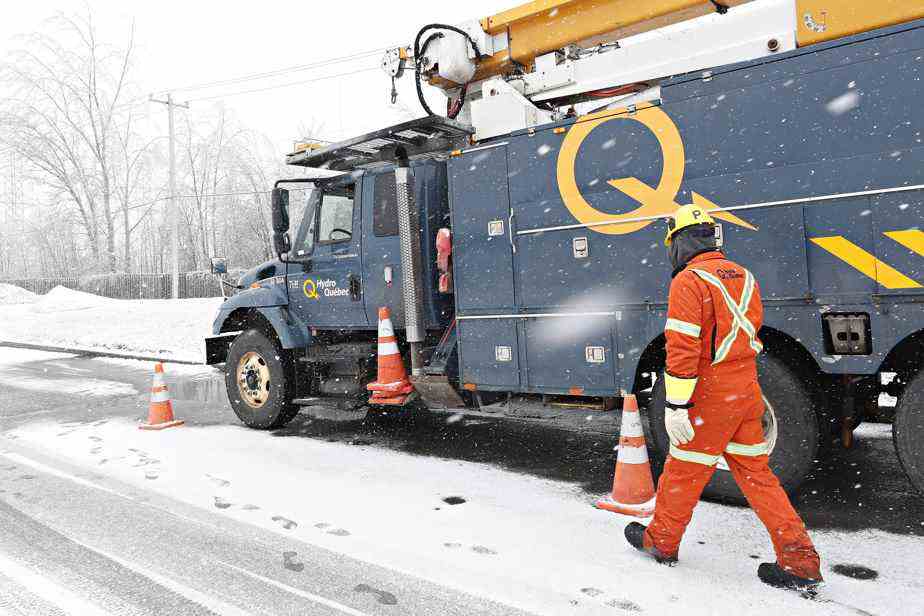The aftermath of the storm that swept across Quebec on December 23 is still being felt in Quebec. Thousands of Quebecers are still in the dark and dozens are recovering from carbon monoxide poisoning.
Five days after the storm that plunged thousands of Quebecers into darkness for Christmas, Hydro-Québec is still working to reconnect more than 11,000 customers across the province. Some customers could still wait until Thursday.
“There is progress, because 95% of customers affected by power outages related to the storm have regained service,” explains Lynn St-Laurent, head of media relations at Hydro-Québec. That said, the remaining 5% is also very important. »
Wednesday morning, more than 19,000 Hydro-Quebec customers were still without power. At the end of the afternoon, this number rose to more than 11,000. “We are doing everything possible to restore service in the hours to come, in some cases, it could go to tomorrow, detailed Mme St-Laurent in the middle of the day. It is difficult to establish with great precision, because you have to go on site to assess the repairs to be made. »
Repairs that affect a few customers at a time
The state-owned company has shared its “recovery strategy” in recent days, which it uses to prioritize the most urgent repairs. First, there are places that pose an imminent threat to public safety, such as hospitals, for example. For residential and commercial customers, Hydro-Québec first prioritizes repairs that will benefit the greatest number of users.
By that logic, ongoing repairs on Wednesday are affecting smaller numbers of homes at a time in more remote areas. “We have teams that go to the place of the break on racket, illustrates Mme St-Laurent. These are operations that are longer and when the repair is done, it is not by the thousands that we can count [le nombre de clients rebranchés]. »
According to the latest data available, 40% of outages still in progress represent one to five Hydro-Québec customers at a time, 22% affect 6 to 10 customers, 20% 11 to 20 customers, 12% 21 to 50 customers and 5 % 51 customers and more.
For a fifth consecutive day, many flights are also still delayed or canceled at Montreal’s Pierre-Elliott-Trudeau airport.
Dozens of carbon monoxide poisonings
“The Quebec poison control center has identified 65 suspected cases of carbon monoxide poisoning over the past week, whereas normally the average number of suspected cases is around 15 cases in a week,” the agency said. The Press Mélanie Otis, media relations at the CIUSSS de la Capitale-Nationale.
In this region particularly affected by power outages, 26 cases of carbon monoxide poisoning have been reported to the public health department, adds Ms.me Otis. On the North Shore, another region affected by electrical breakdowns, 18 cases of carbon monoxide poisoning are under investigation, and seven others in the Mauricie and Centre-du-Québec region.
Two people also died, one in the Quebec region and another in Mauricie.
The majority of poisonings are due to generators that have been placed inside buildings, such as in a basement or garage. “These generators produce a lot of carbon monoxide,” says Dr.r Dominique Buteau, head physician of the hyperbaric medicine service at the Hôtel-Dieu de Lévis. Propane and charcoal fireplaces or barbecues were also used inside.
“Often, people will think that opening the garage door ajar, or opening the basement window will be enough to let the monoxide escape, but that’s not true,” adds the doctor. It’s a treacherous gas, it’s not called the “silent killer” for nothing, it is odorless and colorless, so you can get poisoned quickly without realizing it. »
On the night of December 24 to 25, the hyperbaric medicine service responded to an “avalanche of calls” from emergency rooms in different regions concerning poisoned patients. Four of them were treated in hyperbaric medicine, in Lévis.
The symptoms of carbon monoxide poisoning are varied: headaches, dizziness, feeling of weakness, loss of consciousness, etc. Severe poisoning can lead to death. And even mild poisoning can leave sequelae, also reminds the Dr Buteau, such as memory loss, attention difficulties or balance disorders.
National parks closed
The Society of Outdoor Establishments of Quebec (SEPAQ) announced on December 24 the closure of two of its national parks, that of Jacques-Cartier, located near Quebec, and that of Monts-Valins, in Saguenay. Their reopening is scheduled for December 30, says Simon Boivin, media relations manager for SEPAQ. At Parc national de la Jacques-Cartier, “the trails are not passable due to overturned trees and broken branches,” he says.
Significant damage was also reported in Parc national du Bic, located near Rimouski in Bas-Saint-Laurent. “Most of the trails are inaccessible due to frost or major obstructions caused by the numerous trees blown over by the wind,” points out Mr. Boivin.
On Wednesday, Pointe-Taillon National Park, on the shores of Lac-Saint-Jean, still lacks electricity, but remains accessible to the public.
Learn more
-
- 1200
- Number of workers deployed since the storm to repair power outages
Lynn St-Laurent, head of media relations at Hydro-Québec
